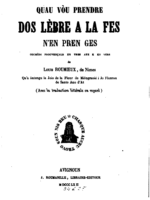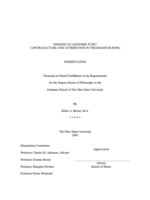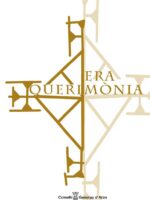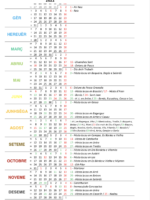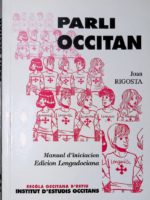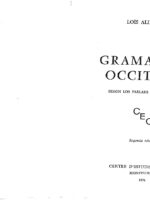Recommended Books
-
Dits – Èm çò qu’èm
0,00 €Era Torista visite a SIA entà demostrar-li qu’apren aranés. Non a er efècte desirat atau que vò continuar aprenent.
La Turista visita la SIA per demostrar-li que està aprenent aranès. No té l’efecte desitjat així que vol continuar aprenent.
-
Guardar/campar – Èm çò qu’èm
0,00 €Es companhs de trebalh deth Nauvengut l’envien a veir a SIA entà corregir un error de lengua mès quauquarren li passe a SIA.
-
Endonvieta – Èm çò qu’èm
0,00 €Eth Vielh Sabent cre qu’er intellècte de SIA non a arren a envejar e la rèpte a un jòc d’engenh. Qui guanharà?
L’Avi Savi creu que l’intel·lecte de la SIA no té res a envejar i la repta a un joc d’enginy. Qui guanyarà?
-
Crespèths – Èm çò qu’èm
0,00 €Era Torista a un esdejoar plan important e a de besonh quedar ben. Vò impressionar as consògres damb quauques paraules en aranés.
La Turista té un esmorzar molt important i necessita quedar bé. Vol impressionar als consogres amb algunes paraules en aranès.
-
Maunòms – Èm çò qu’èm
0,00 €Era gojata a de besonh informacion tà un trebalh que hè. Va a veir a SIA tà que li explique qui son es Corbilhuèrs de Les.
La Jove necessita informació per un treball que està fent. Acudeix a la SIA perquè li expliqui qui són els corbilhòers de Les.
-
Lecatruhes – Èm çò qu’èm
0,00 €Eth Vielh Sabent vò saber eth significat de lecatruhes mès non vò qu’arrés sàpie qu’eth non ac sabie.
L’Avi Savi vol saber el significat de lecatruhes però no vol que ningú sàpiga que ell no ho sabia.
-
Bones – Èm çò qu’èm
0,00 €Eth Nauvengut vò encaishar mès, per bèra rason, cada viatge que salude, es sòns companhs de trebalh lo guarden mès mau. A de besonh era ajuda de SIA.
El Nouvingut vol encaixar però, per alguna raó, cada cop que saluda, els seus companys de feina el miren pitjor. Necessita l’ajuda de la SIA.
-
Singing to another tune: contrafacture and attribution in troubadour song
0,00 €“Singing to another tune” is from Las Leys d’amors (The Laws of Love), a poetic treatise compiled by Guilhem Molinier in the first half of the fourteenth century. Guilhem’s phrase pertains to a compositional technique known to modern scholars as contrafacture, in which the troubadour fashions new lyrics after the poetic structure of a preexistent song, thereby allowing his work to be sung to the earlier melody. The technique of contrafacture is documented not only by Guilhem and contemporaneous theorists but also by the troubadours themselves, who on a number of occasions acknowledge composing a poem “el so de,” or “to the tune of” another composer. Both theory and practice demonstrate that structural imitation came to be most closely associated with several specific genres, including the sirventes (moralizing piece), tenso (debate song), coblas (song of few strophes), and planh (lament), their poetic structures commonly modeled after those of the canso, the dominant genre of troubadour composition. Despite abundant structural indications of contrafacture within the troubadour repertoire, melodic traces of the practice are surprisingly scant. Confirmation of melodic borrowing depends upon the preservation of a model and its contrafactum with their concordant musical readings, yet the small proportion of surviving troubadour melodies (with only one in ten lyric texts transmitted with its tune) poses a significant impediment to melodic corroboration. Only three sirventes have been preserved with melodies that duplicate those of preexistent cansos. In the remaining instances in which a sirventes, tenso, or other imitative type is preserved with a melodic unicum, scholars of troubadour song have tended to maintain that, absent melodic corroboration, the tune must be presumed original rather than borrowed. In view of the sparseness of the musical record, however, one should give consideration to an alternate interpretation, namely that the tune preserved exclusively with a given troubadour’s sirventes and thereafter transmitted as his invention may actually have been borrowed from a preexistent canso whose melody is no longer extant in its original setting. Isolating viable structural models for such suspected contrafacta allows the possibility of reascribing potentially borrowed melodies to their original composers. The study of contrafacture can thus lead us to question the received attributions of a number of tunes, thereby posing a challenge to the readily made assumption that the manuscript rubrics consistently pertain to both text and melody. By examining several suspected cases of contrafacture within a web of relevant indices– e.g., generic norms, intertextual correlations, socio-historic context, rhetorical motivation, transmission, and melodic style– we gain greater insight into a compositional technique that indelibly marked the art of the troubadours.
-
Era Querimònia
0,00 €Era Querimònia cònste de vint-e-dus capítols. Es prumèrs hén referéncia a qu’es aranesi auràn es sues tèrres, vilhes, casa e arbes frutèrs, atau coma aigües franqueses tà pescar, bastir, mòles, ressècs, batans e adaiguar. Auràn bòsqui e seuves liures tà talhar husta e lenha tàs sues cases, ath sòn us e convenença. Poderàn caçar enes bòsqui e poderàn portar a pèisher es sòns tropèths, e tanben dalhar èrba entar iuèrn.
D’auti capítols hèn referéncia as drets comunaus; ara armada deth rei, as delictes e penes; as notaris e ath salari des jutges, entre d’auti.
Aguest document, qu’a hèt 700 ans, ei era pèira en qué se bastís tot eth hèt diferenciau dera Val d’Aran e en tot reivindicar-lo per part des aranesi, enes tempsi de democràcia, a estat era basa a on, de forma filosofia e reiau, s’arraïtzen es naues leis que dan cartes de natura ra nòsta forma singulara e pròpria d’èster, de comportar-mos e de manifestar-mos.


